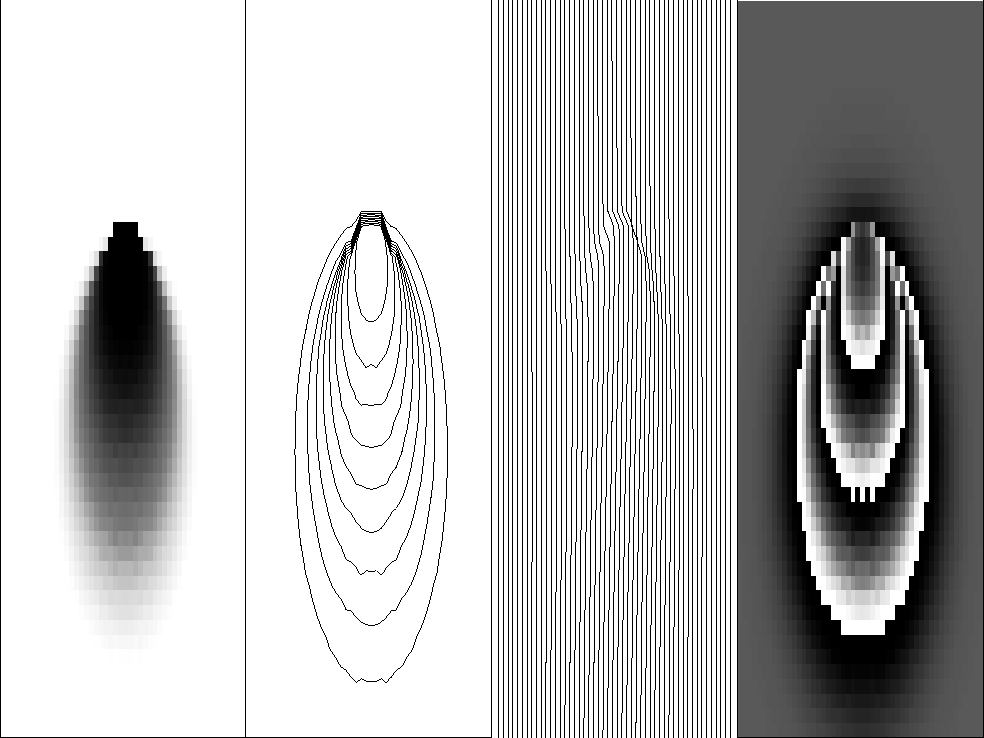




Next: THE WORLD OF CONJUGATE
Up: VESUVIUS PHASE UNWRAPPING
Previous: Estimating the inverse gradient
The viewing angle (23 degrees off vertical)
in Figure 2 might be such
that the mountain blocks some of the landscape behind it.
This leads to the interesting possibility
that the phase function must have a discontinuity
where our viewing angle jumps over the hidden terrain.
It will be interesting to discover whether
we can estimate functions with such discontinuities.
I am not certain that the Vesuvius data
really has such a shadow zone, so I prepared the synthetic
data in Figure 6,
which is noise free and definitely has one.
We notice the polarity of the synthetic data in 6
is opposite that of the Vesuvius data.
This means that the radar altitude of Vesuvius is
not measured from sea level but from the satellite level.
A reason I particularly like this Vesuvius exercise
is that slight variations on the theme occur in various other fields.
For example,
in 3-D seismology
we can take the cross-correlation of each seismogram
with its neighbor and pick the time lag of the maximum correlation.
Such time shifts from trace to trace
can be organized as we have organized the  values of Vesuvius.
The discontinuity in phase along the skyline of our Vesuvius view
is like the faults we find in the earth.
values of Vesuvius.
The discontinuity in phase along the skyline of our Vesuvius view
is like the faults we find in the earth.
EXERCISES:
-
In differential equations,
boundary conditions are often (1) a specified function value
or (2) a specified derivative.
These are associated with (1) transient convolution
or (2) internal convolution.
Gradient operator igrad2
![[*]](http://sepwww.stanford.edu/latex2html/cross_ref_motif.gif) is based on internal convolution with the filter (1,-1).
Revise igrad2 to make a module called tgrad2
which has transient boundaries.
Hint: Compare with
icai2
is based on internal convolution with the filter (1,-1).
Revise igrad2 to make a module called tgrad2
which has transient boundaries.
Hint: Compare with
icai2 ![[*]](http://sepwww.stanford.edu/latex2html/cross_ref_motif.gif) and
tcai2
and
tcai2 ![[*]](http://sepwww.stanford.edu/latex2html/cross_ref_motif.gif) .
.
synmod90
Figure 6
Synthetic mountain with hidden backside.
For your estimation enjoyment.










Next: THE WORLD OF CONJUGATE
Up: VESUVIUS PHASE UNWRAPPING
Previous: Estimating the inverse gradient
Stanford Exploration Project
2/27/1998
![]() values of Vesuvius.
The discontinuity in phase along the skyline of our Vesuvius view
is like the faults we find in the earth.
values of Vesuvius.
The discontinuity in phase along the skyline of our Vesuvius view
is like the faults we find in the earth.
![[*]](http://sepwww.stanford.edu/latex2html/cross_ref_motif.gif) is based on internal convolution with the filter (1,-1).
Revise igrad2 to make a module called tgrad2
which has transient boundaries.
Hint: Compare with
icai2
is based on internal convolution with the filter (1,-1).
Revise igrad2 to make a module called tgrad2
which has transient boundaries.
Hint: Compare with
icai2 ![[*]](http://sepwww.stanford.edu/latex2html/cross_ref_motif.gif) and
tcai2
and
tcai2 ![[*]](http://sepwww.stanford.edu/latex2html/cross_ref_motif.gif) .
.
